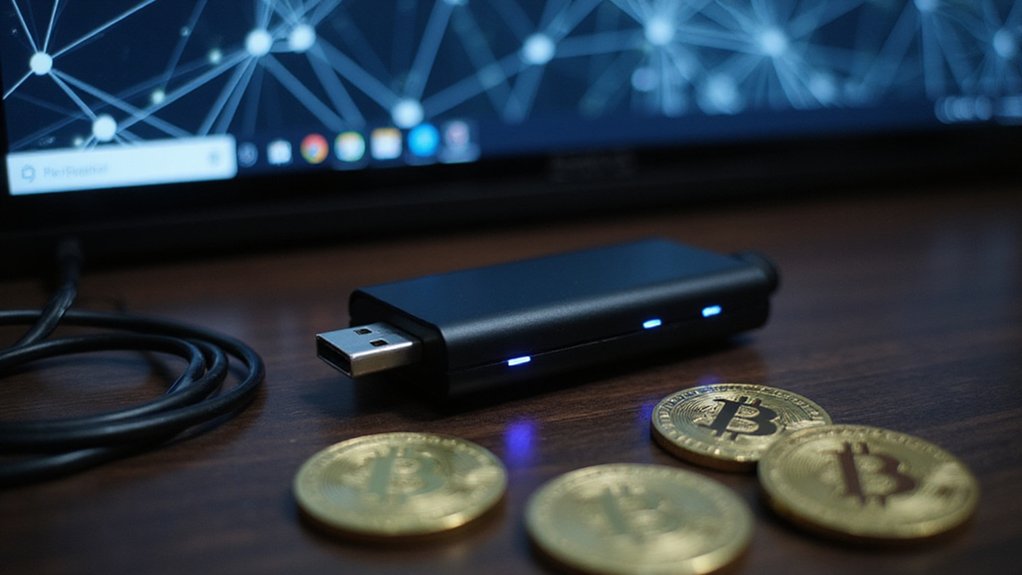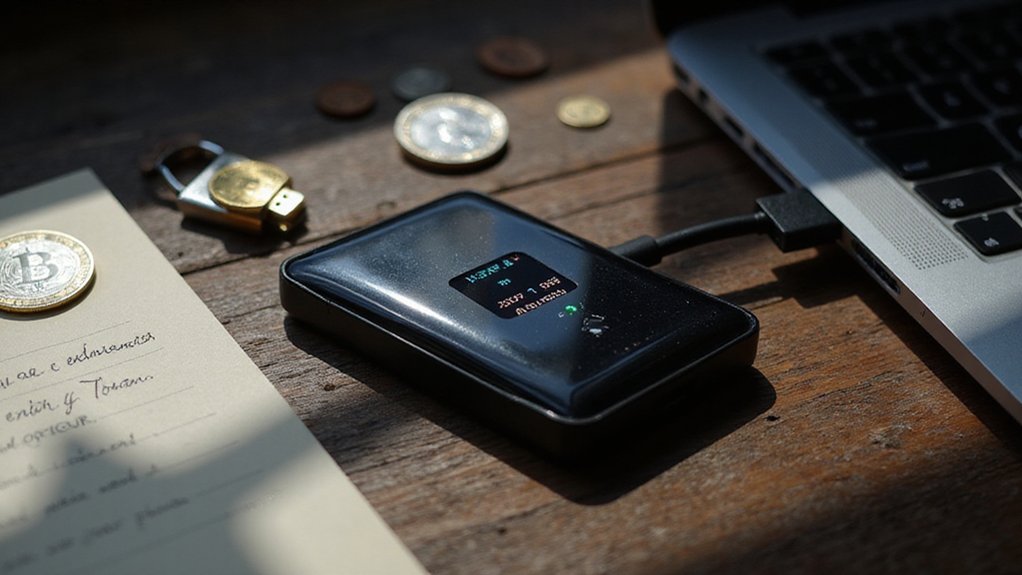Hardware wallets are specialized physical devices that store cryptocurrency private keys offline in tamper-resistant secure elements, ironically requiring tangible hardware to protect purely digital assets. These USB-like devices sign transactions internally without exposing private keys to internet-connected computers, effectively creating an air gap between valuable cryptographic keys and potential online threats. With PIN protection, passphrase support, and backup seed phrases for recovery, hardware wallets trade convenience for security in irreversible transaction environments where a single mistake can cost millions—a prudent paranoia that reveals deeper complexities.

The irony of cryptocurrency—a digital revolution designed to eliminate traditional financial intermediaries—demanding its own specialized hardware for basic security would be amusing if it weren’t so critically necessary.
Hardware wallets represent the physical manifestation of a purely digital concept, resembling ordinary USB drives while housing extraordinary security infrastructure that protects what amounts to strings of alphanumeric characters worth potentially millions.
These devices function through deceptively simple mechanics: private keys remain imprisoned within tamper-resistant secure elements, never venturing into the treacherous online environment where hackers prowl with algorithmic persistence.
When transactions require authorization, the wallet receives unsigned transaction data, performs cryptographic signing internally using its sequestered private keys, then broadcasts the signed transaction to blockchain networks—all while maintaining the digital equivalent of an air gap.
The security architecture combines multiple defensive layers, each addressing different threat vectors.
PIN protection prevents unauthorized access (though one wonders why securing digital gold requires the same technology as accessing checking accounts), while passphrase support adds cryptographic complexity that would make Renaissance codebreakers weep.
Tamper-evident seals provide physical security assurance, because apparently even digital assets require analog protection methods.
Recovery mechanisms acknowledge the inevitable human tendency toward misplacement and digital catastrophe.
Backup seed phrases—typically twelve to twenty-four words that somehow contain entire financial universes—enable wallet restoration when devices meet unfortunate ends through washing machines, coffee spills, or simple disappearance into dimensional voids commonly known as junk drawers.
Hardware wallets occupy a peculiar market position compared to their software counterparts.
While software wallets offer convenience and zero upfront costs, they expose private keys to internet-connected devices where malware lurks with predatory patience.
Hardware solutions demand initial investment and technical setup complexity that challenges users who struggle with television remotes, yet provide security levels approaching paranoia—which, in cryptocurrency contexts, constitutes prudent risk management. Unlike hot wallets that maintain constant internet connectivity, hardware wallets operate as cold storage solutions that remain offline except during specific transaction moments. Proper wallet encryption with strong passwords creates an additional security barrier that protects against unauthorized access even if the physical device falls into wrong hands. Many models achieve remarkable versatility by supporting multiple blockchains on a single device, allowing users to manage diverse digital asset portfolios without maintaining separate storage solutions for each cryptocurrency type.
The fundamental value proposition remains unchanged: trading convenience for security in an ecosystem where irreversible transactions make traditional banking’s safety nets appear luxurious.
Hardware wallets transform abstract digital wealth into tangible, pocket-sized responsibility—a curious evolution for assets that exist primarily as mathematical concepts distributed across global computer networks.
Frequently Asked Questions
Can Hardware Wallets Be Hacked or Compromised by Malware?
Hardware wallets can indeed be compromised through sophisticated malware attacks, particularly malicious firmware like “Dark Skippy” that extracts seed phrases from transaction signatures.
While these devices resist traditional software-based attacks, they remain vulnerable to supply chain tampering, firmware manipulation, and physical fault injection techniques.
Users who assume hardware wallets provide absolute security—a remarkably persistent misconception—often neglect proper verification of firmware updates and secure sourcing practices.
What Happens if I Lose My Hardware Wallet Device?
Losing a hardware wallet device triggers the recovery process through the seed phrase—assuming one had the foresight to properly store this critical backup.
Users simply download compatible wallet software, create a new wallet instance, and manually enter their recovery phrase to restore full access to funds.
The physical device becomes irrelevant (though one might miss those satisfying button clicks), as the seed phrase remains the true gateway to cryptocurrency holdings.
Do Hardware Wallets Work With All Cryptocurrency Types?
Hardware wallets don’t universally support every cryptocurrency—a reality that occasionally frustrates users discovering their obscure altcoin remains unsupported.
Leading devices like Ledger support thousands of assets, while Trezor focuses on popular cryptocurrencies including Bitcoin, Ethereum, and surprisingly, meme coins like Pepe.
SecuX claims compatibility with over 10,000 cryptocurrencies.
Support typically depends on blockchain architecture and manufacturer priorities, though major coins enjoy near-universal compatibility across reputable hardware wallet brands.
How Much Do Hardware Wallets Typically Cost?
Hardware wallets typically cost between $49-$399, depending on features and brand prestige.
Entry-level models like the Trezor Model One ($59) provide basic security, while mid-range options ($79-$169) offer enhanced screens and broader cryptocurrency support—as previously discussed regarding compatibility.
Premium devices like Ledger’s Stax ($399) include touchscreens and Bluetooth connectivity.
Notably, price doesn’t always correlate with security effectiveness; some budget options rival expensive alternatives in protection capabilities.
Can I Use Multiple Hardware Wallets for the Same Cryptocurrencies?
Cryptocurrency holders can absolutely deploy multiple hardware wallets for identical assets—a strategy offering both redundancy and segregation benefits.
One can either use different devices with the same seed phrase (creating backup redundancy) or employ separate seeds across devices (segregating risk pools).
The former approach mirrors having multiple keys to the same vault, while the latter resembles maintaining entirely separate safety deposit boxes for diversified asset protection.









